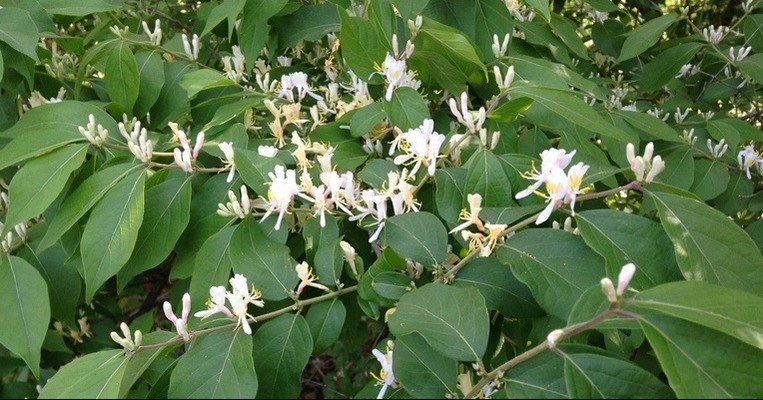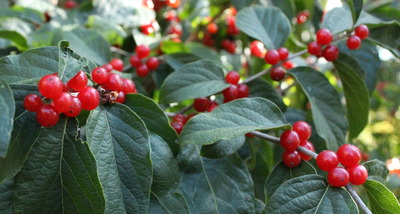
Bush honeysuckle spreads up to 15-20 feet in height with flowers that change from white to yellow. (Photo courtesy of Kansas Forest Service) | Download this photo
Forest officials urge removal of Callery pear, bush honeysuckle
Invasive species are forcing out native vegetation, says state forest health expert
At a glance: A Kansas Forest Service official is urging Kansans to be on the lookout for the Callery pear tree and bush honeysuckle, a pair of invasive species that threaten the state’s forests and ecosystems by pushing out native vegetation.
More information: Ryan Rastok, rrastok@ksu.edu, 785-410-0399
March 25, 2024
By Pat Melgares, K-State Research and Extension news service
MANHATTAN, Kan. – A Kansas Forest Service official is urging Kansans to be on the lookout for a pair of invasive species that threaten the state’s forests and ecosystems by pushing out native vegetation.
Ryan Rastok, the forest health coordinator with KFS, said Callery pear and bush honeysuckle are especially meddlesome this time of year.
“I was flying back from Georgia into Kansas City recently and as we were flying into the airport, I could see an abundance of callery pear, even from the plane,” Rastok said.
![]() For a brief time – often in early April – the Callery pear puts on a stunning display of white flowers. But behind the beauty belies a menace.
For a brief time – often in early April – the Callery pear puts on a stunning display of white flowers. But behind the beauty belies a menace.
At right: Callery pear tree in full bloom. (Photo courtesy of Kansas Forest Service) | Download this photo
Native to China, the Callery pear includes 26 cultivars that present significant ecological concerns in Kansas and Missouri. Among them:
- It displaces native trees and plants in the wild, which lowers ecologocial biodiversity. The tree does not host native pollinators.
- It leafs out before woodland wildflowers emerge from dormancy, robbing them of critical sunlight and preventing their growth.
- Its’ egg-shaped structure – at heights of 30-40 feet – and brittle wood make it prone to falling limbs that can damage people and property.
And, Rastok says, it smells.
“Yeah, there’s been a myriad of descriptions for the smell, most of them vile and maybe some not appropriate to say out loud,” he said.
Rastok said the Kansas Forest Service and several partners are sponsoring a Callery pear ‘buyback’ in late April and early May. To qualify, landowners must cut down a blooming Callery pear tree, and send in a photo. Supplies are limited, but landowners may receive an option for one of nearly a dozen replacement trees at no cost.
More information is available at https://deeproots.org/callery-pear-events.
Bush Honeysuckle is another invasive that Rastok urges homeowners to identify and remove. The shrub spreads up to 15-20 feet in height with flowers that change from white to yellow; juicy red berries; and opposite, simple leaves that green up much earlier than surrounding native vegetation.
 At right: Bush honeysuckle with red berries. (Photo courtesy of Kansas Forest Service) | Download this photo
At right: Bush honeysuckle with red berries. (Photo courtesy of Kansas Forest Service) | Download this photo
The shrub typically flowers in May or June, and unlike the Callery pear, is more fragrant.
Rastok said not counting such human activities as urban sprawl and others, bush honeysuckle “is the biggest threat to our native forests and ecosystems in Kansas, and it’s continuing to spread so we need to keep the pressure on that one, as well. The biggest issue right now is that it’s starting to establish in the state’s woodlands where it will eventually push out our native vegetation…it simplifies the ecosystem by lowering its overall floral and faunal diversity.”
Neither the Callery pear nor the bush honeysuckle are easily managed by prescribed burning, Rastok said. More information on controls, and options for replenishing areas where trees have been removed, is available from the Kansas Forest Service, www.kansasforests.org, or by contacting Rastok, rrastok@ksu.edu or 785-410-0399.
***

K‑State Research and Extension is a short name for the Kansas State University Agricultural Experiment Station and Cooperative Extension Service, a program designed to generate and distribute useful knowledge for the well‑being of Kansans. Supported by county, state, federal and private funds, the program has county extension offices, experiment fields, area extension offices and regional research centers statewide. Its headquarters is on the K‑State campus in Manhattan. For more information, visit www.ksre.ksu.edu. K-State Research and Extension is an equal opportunity provider and employer.